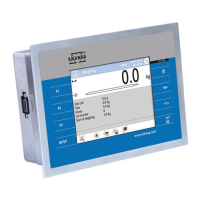164
The excess of liquid pouring through the capillary tube is removed with an
absorbent paper. Then, the vessel is immediately placed on a scale, and its
mass is determined as quickly as possible. During the mass measurement, due
to contraction of the volume of liquid its level usually decreases in the capillary
tube, but this does not matter if at the time of placing instrument on the scale, it
was completely filled and had correct temperature. Small diameter of the
capillary tube prevents evaporation of
the liquid from the vessel, and therefore it does not affect the measurement
result.
Before starting the density determination using a pycnometer, data on its
volume and mass should be inserted to scale’s memory. If pycnometer’s mass
is not specified in the local parameters, than the process starts with
determining mass of an empty pycnometer.
Process course:
• Press < Local parameters> key to enter the setting of local
parameters in density mode.
• Press < Pycnometer mass> key to insert the mass of a
pycnometer used for determining density of tested liquid. Pycnometer’s
mass is expressed in grams [g]. Accept inserted
value by pressing
key.
• Press < Pycnometer volume> to specify the volume of the
pycnometer used for determining density of tested liquid. The volume
is expressed in grams [cm
3
]. Accept inserted value by pressing
key.
• Press < Temperature> key and specify the temperature in which the
test of liquid density determination is carried out. The temperature
value is expressed in [°C]. Accept inserted value by pressing
key. The temperature serves here for information purpose, and it is
placed on reports from carried out processes.
• On specifying the parameters exit to main menu of the density
mode by pressing
key.
• In order to start density determination using a pycnometer, press
<
Determine pycnometer density> key, using a pre-defined
hot keys on indicator’s display.

